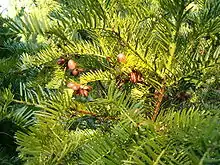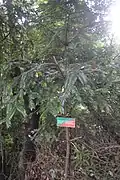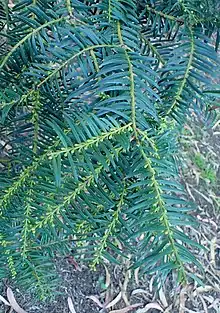Cephalotaxus
Cephalotaxus, commonly called plum yew or cowtail pine, is a genus of conifers comprising 11 species, treated in either the Cephalotaxaceae, or in the Taxaceae when that family is considered in a broad sense.[1][2] The genus is endemic to eastern Asia, though fossil evidence shows it had a wider Northern Hemisphere distribution in the past.[1] The species are evergreen shrubs and small trees reaching 1.0–10 m (rarely to 20 m) tall.
| Cephalotaxus | |
|---|---|
 | |
| Cephalotaxus harringtonii | |
| Scientific classification | |
| Kingdom: | Plantae |
| Clade: | Tracheophytes |
| Division: | Pinophyta |
| Class: | Pinopsida |
| Order: | Pinales |
| Family: | Taxaceae |
| Genus: | Cephalotaxus Siebold & Zucc. ex Endl. |
| Type species | |
| Cephalotaxus harringtonii | |
| Species | |
|
Cephalotaxus fortunei | |
Description
The leaves are spirally arranged on the shoots, but twisted at the base to lie in two flat ranks (except on erect leading shoots); they are linear, 4–12 cm long and 3–4 mm broad, soft in texture, with a blunt tip; this helps distinguish them from the related genus Torreya, which has spine-tipped leaves.[2]
The species can be either monoecious or dioecious; when monoecious, the male and female cones are often on different branches. The male (pollen) cones are 5–8 mm long, grouped in lines along the underside of a shoot. The female (seed) cones are single or grouped two to 15 together on short stems; minute at first, they mature in about 18 months to a drupe-like structure with the single large nut-like seed 1.5–4 cm long surrounded by a fleshy covering, green to purple at full maturity. Natural dispersal is thought to be aided by squirrels which bury the seeds for a winter food source; any seeds left uneaten are then able to germinate.[2]
Extant species
| Image | Scientific name | Common name | Distribution |
|---|---|---|---|
.jpg.webp) | Cephalotaxus fortunei | Chinese plum-yew | northern Burma and China |
 | Cephalotaxus griffithii | Griffith's plum yew | northern India, northern Myanmar and the western Sichuan Province in China. |
| Cephalotaxus hainanensis | Hainan plum-yew | Hainan in southern China | |
 | Cephalotaxus harringtonii | Japanese plum-yew, Harrington's cephalotaxus, or cowtail pine | from Kyūshū in the south to Hokkaidō, Japan |
 | Cephalotaxus koreana | Korean plum yew | Korea, Japan and northeast China |
| Cephalotaxus lanceolata | Gongshan plum yew | northern Burma and southern China | |
| Cephalotaxus latifolia | Broad-leaved plum yew | southern China | |
 | Cephalotaxus mannii | Mann's yew plum | southern China, northeast India, Laos, northern Thailand, northern Myanmar and northern Vietnam. |
 | Cephalotaxus oliveri | Oliver's plum yew | China and possibly to Thailand, Laos, Vietnam and eastern India. |
 | Cephalotaxus sinensis | Chinese plum yew | central and southern China. |
 | Cephalotaxus wilsoniana | Taiwan plum yew, Taiwan cow's-tail pine, and Wilson plum yew | Taiwan |
References
- Tripp, Kim E. (1995). "Cephalotaxus: the plum yews". Arnoldia. 55 (1): 25–39.
- Christopher J. Earle (2011). "Cephalotaxus". The Gymnosperm Database. Archived from the original on 30 March 2012. Retrieved 31 March 2012.